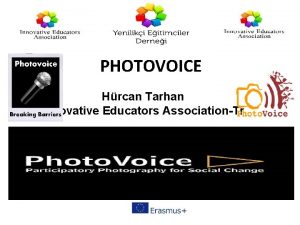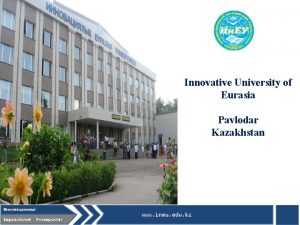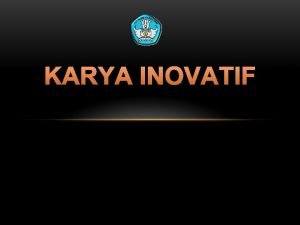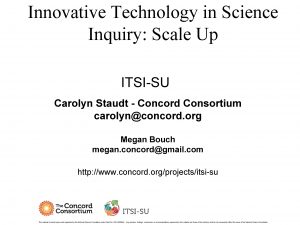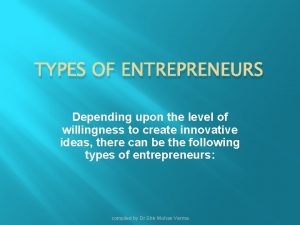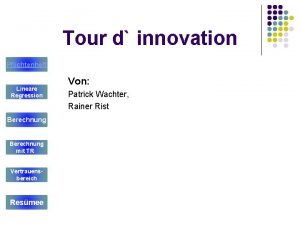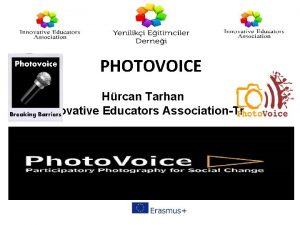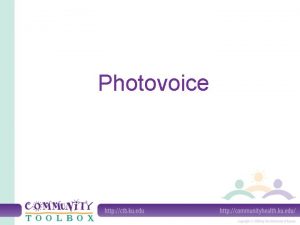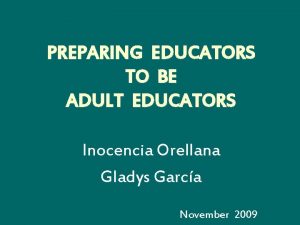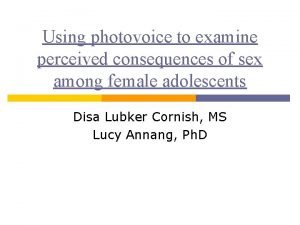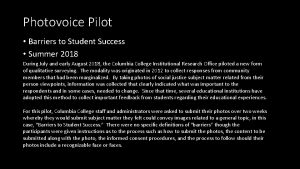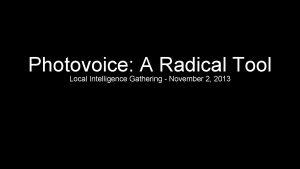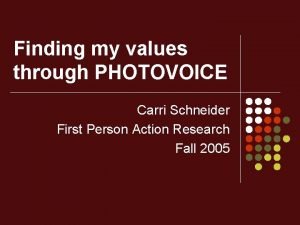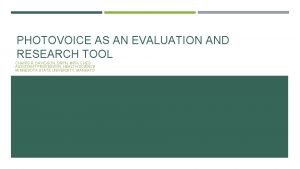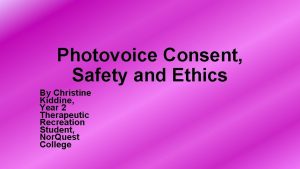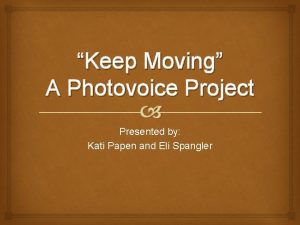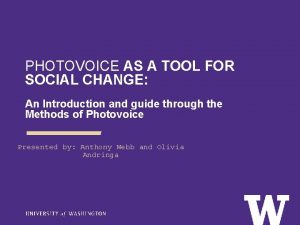PHOTOVOICE Hrcan Tarhan Innovative Educators AssociationTr What is
















































- Slides: 48

PHOTOVOICE Hürcan Tarhan Innovative Educators Association-Tr

What is Photovoice? It is a participatory action and research method in which people; usually those with little power and opportunity § create and discuss photographs to picture their environment and experiences, § to express their thoughts and as a means of catalyzing personal and community change. § Using cameras, participants document the reality of their lives.

History of Photovoice was originally developed in China in 1992 by Caroline C. Wang of the University of Michigan and Mary Ann Burris, program officer for women’s health at the Ford Foundation. It was created as a way to enable rural women of Yunnan Province, China, to influence the policies and programs that affected them. • Since then, Photovoice’s successful model and techniques such as photo-elicitation and digital storytelling have allowed often-marginalized participants to create visuals that capture their individual perspectives. It has been employed across the world, allowing people to express and share their stories, their way, and promote social change globally.

The goals of Photovoice: Making voices heard • It involves people that have little or no opportunity to express their views in their own communities or to influence decision that may affect their lives Encouraging self-development • It empowers individuals to take control of their lives and to become actively engaged in helping themselves

Providing the means to generate income The skills that the participants gain during the project expand their career and training options (related to photography or life skills as confidence, selfesteem, . . . relevant to any kind of employment or training) To instill critical consciousness It promotes CRITICAL REFLECTION on individual and important community matters To influence policy Sharing the results with the community through the final exhibition stimulate a CRITICAL DIALOGUE on important matters

Why should you use Photovoice? Ø Basic photography is easy to learn and accessible to almost everyone Ø Taking photographs of familiar scenes and people can change participants’ perceptions about their social and physical environment. Ø Images can be understood regardless of language, culture, or other factors. Ø Pictures, by creating a clear record of what exists at a particular point in time, can be used to hold policy makers and others accountable. Ø Photography provides a means for empowerment without requiring people to stand up and speak in public.

Why photography Ø Photography is a highly flexible tool that crosses cultural and linguistic barriers, and can be adapted to all abilities. Its power lies in its dual role as both art form and way to record facts. Ø It provides an accessible way to describe realities, communicate perspectives, and raise awareness of social and global issues. Ø Its low cost and ease of dissemination encourages sharing and increases the potential to generate dialogue and discussion.

How do you use Photovoice? General guidelines: Ø Photovoice should be a participatory, collaborative process from the beginning. Ø Participants and staff need training. Ø Participants need support. Ø The project should result in some actions.

Method 1. Develop and define It is important to establish your project's overall goal (WHAT IS CONTRIBUTING TO) and its specific aims This is the stage at which the core purpose of a project is defined and established and the project activities are developed in line with resources and timeframe. This phase of project design involves research about the target group, working with communities and partners to establish the needs, priorities, dynamics and expectations and then agreeing on a project plan that will best use participatory photography methods to meet the identified needs and objectives.

Workshops This is the creative core of the project where participants: 1) Work with facilitators to learn photographic and digital media techniques, discuss about theme, learn rules of ethical and safe photography in various situations, learn how to work in a group, build skills and confidence. 2) Get out and take pictures 3) Work regularly in small groups to discuss and reflect on the experience and the pictures, and to choose each participant’s best photographs. As a group the participants choose a common THEME to put forward a PROPOSAL FOR CHANGE The contents, length and frequency of workshops varies in each project

Going public This is the culmination of the project process when the images and words created are put together in a curated form and shared with a public audience. This audience may be limited to family and friends or extend to a general public audience or targeted groups such as specific community members – eg. peers, youth, parents, local residents – or power brokers–eg. politicians or local service providers. Images can be shared publicly in numerous and multiple formats and platforms. Many projects engaged in media and press work in order to publise the issues and extend its audience

EXAMPLE of Photovoice • • Unemployment Entrpreneurship Education Innovation Creativity Career Differentiation














“Sibilla”: a prevention project about “new drugs” "The reflection of a girl who looks in the mirror corresponds to the appearance that often tend to value most. " "In a psychedelic, young people immersed in the confusion of a deafening rhythm are lost!" "The face of Julia with open and bright smile recalls the naturalness and spontaneity is not necessary to adapt to the ground. " "Young party have fun in a healthy and conscious. "

- Meanings "A place abandoned by God. . . but not by the clergy!" "There are many facilities aimed at children or the elderly, but completely lack of facilities catering to a harmonious growth and away from deviance for teenagers. A proposal that I could do about it is to use public money more in favor of adolescents, organizing activities targeted leveraging public spaces, making the time boys less "Open the gates to us!" "Reassess the building to allow group activities and entertainment for all!"

“Images contribute to how we see ourselves, how we define and relate to the world, and what we perceive as significant or different. The lesson an image teaches does not reside in its physical structure, but rather in how people interpret the image in question. ” Carolyn C. Wang, Photovoice Creator/Researcher

QUESTIONS TO EXPLORE THE PHOTOGRAPHS 1) 2) 3) 4) 5) 6) 7) 8) 9) 10) 11) 12) What is the story of this photograph? It is a photograph of who, of what? What does it talk about? How did it come to be taken? What thoughts, feelings, or memories come to mind as you look at it? Why do you think the photographer took it, and were she/he satisfied with the result? What might you title this photo? If it could speak, what might it say or ask? What messages or secrets might it hold? What are the 3 words that come to your mind looking at this photograph? Do you like something in particular of this photograph? What do not you like of it? Do you think that something is missing in this photograph or would you like to change something in this photograph? Would you like to ask something to this picture?

SOME BASIC INFO TO TAKE PICTURES Ø These are just guidelines which of course can and are often broken. Ø The composition is of primary importance to make a good photo. You need a good composition to create an effective image. Ø Here are some simple rules as useful suggestions to follow:

1 Rule of three parts 2 The border/the frame 3 Guidance lines

1° Rule of three parts

Imagine your photo is divided into a grid of 9 parts (3 x 3). Put the subject of the photo in one of the point of intersection depending on the effect you want to make. If you want to highlight the subject, put it in one of the top points of intersection, without leaving too much empty space above it. It is advisable to put the main subject to the left of the photo (if you put the subject in the centre, the eye of the observer tends to neglet the other details in the photo). If the point of interest is small, always try to include something else interesting to avoid leaving empty spaces. If you want to highlight the idea of isolation, leave the space empty.


2° The border/the frame

Used above all for photos of scenary or architecture. Insert in the foreground a subject which can act as a frame for the image you want to photograph; this give three-dimensionality to the photo. This frame must not be so intrusive that it takes away attention from the main subject. Classic examples are an arch, a door frame, a window or a branch of a tree or plant. The frame can be completely in focus or out of focus.




3° Guidance lines

Guidance lines are important to direct the eye of the observer towards the image and to create depth. Look for the rhythm of repetitive elements, diagonal lines, contrasting elements, strong colours, homogeneity of the design.





Ø Photo. Voice enables a world in which everyone can have the opportunity to speak out and be heard. Ø The goal is to build skills within disadvantaged and marginalised communities. Ø In order to achieve this, we utilise innovative participatory photography, exhibitions and dissemination through digital storytelling methods. Ø A doc-movie can be cretaed with the photos. Ø These skills enable individuals to represent themselves and create tools for advocacy and communication and positive social change can be delivered.


Contact Hürcan TARHAN – hurcantarhan@gmail. com Innovative Educators Association (NGO) www. innovativeduca. com
 Hrcan
Hrcan Caroline c wang
Caroline c wang What is photovoice
What is photovoice How to make a photovoice
How to make a photovoice Missouri educators trust
Missouri educators trust Texas assessment management system administrator
Texas assessment management system administrator Measurement and evaluation for health educators
Measurement and evaluation for health educators Professional association of georgia educators
Professional association of georgia educators Lean innovation educators summit
Lean innovation educators summit Code of ethics for educators georgia
Code of ethics for educators georgia New york harm reduction educators
New york harm reduction educators Georgia code of ethics for educators
Georgia code of ethics for educators Earth educators rendezvous
Earth educators rendezvous Hbr for educators
Hbr for educators Allied educator moe
Allied educator moe Splice
Splice Innovative users group
Innovative users group Innovative university of eurasia
Innovative university of eurasia Microsoft teacher academy
Microsoft teacher academy Innovative train technology
Innovative train technology Innovative ideas to grow business
Innovative ideas to grow business Innovative metal products
Innovative metal products Innovative analytical solutions
Innovative analytical solutions Apa itu karya inovatif
Apa itu karya inovatif Innovative business communication
Innovative business communication Innovative teaching methods in english
Innovative teaching methods in english Innovative integration
Innovative integration Functional vs innovative products
Functional vs innovative products Innovative routines international
Innovative routines international Inventive and innovative
Inventive and innovative Innovative management for a changing world
Innovative management for a changing world Classroom
Classroom Innovative technology in science inquiry
Innovative technology in science inquiry Adam bornstein red cross
Adam bornstein red cross Functional and innovative products
Functional and innovative products These are entrepreneurs who are to follow the path
These are entrepreneurs who are to follow the path Revenue generating ideas for museums
Revenue generating ideas for museums Aaarambbh revolution pvt ltd
Aaarambbh revolution pvt ltd Innovative training techniques
Innovative training techniques Innovative management for turbulent times
Innovative management for turbulent times Innovative features of scripting languages
Innovative features of scripting languages Innovative library services
Innovative library services Innovative features of scripting languages
Innovative features of scripting languages Proses staffing
Proses staffing Innovative change definition
Innovative change definition Creative color wheel with tints and shades
Creative color wheel with tints and shades Innovative regressionsverfahren
Innovative regressionsverfahren Innovative communication tools
Innovative communication tools Innovative business models in agriculture
Innovative business models in agriculture
